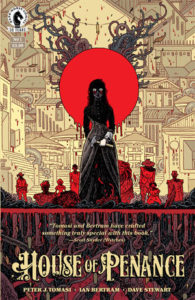
 Written by Peter J. Tomasi
Written by Peter J. Tomasi
Art by Ian Bertram
Colours by Dave Stewart
Letters by Nate Piekos
Review by Billy Seguire
A comic sets a bold tone opening with the exhumation of a family grave. When it follows that imagery with an endless home’s impossible geometry and a focus on deformed, emotionally broken characters, that tone becomes centrally inescapable. It’s a tone that House of Penance #1 revels in, confronting the reader at every turn with an unyielding barrage of existential dread and burdensome anxiety that makes this comic enjoyable for fans of rich, character-driven horror. An engaging story that makes incredible use of its astounding source material, writer Peter J. Tomasi avoids venturing too deeply into the occult at the outset of this tale, choosing instead to pull you slowly into this unlit corner of American history with the details of a truth that’s stranger than fiction.
Based on the true story of the Winchester Mystery House and the legends surrounding its lore, House of Penance portrays the historic Sarah Winchester as a widow lost to grief in a permanently depressive state. Her design is dark and gothic, with wide-set eyes and a gaunt figure exemplifying her alienation from the remainder of the world. It’s a character design meant to evoke emotion rather than represent physical features, and its success is felt on a fundamental level, as one can’t help but look at Sarah Winchester and see her as anything but other. A living ghost, Bertram’s unblinking depiction of Sarah and her obsessive impulses elevates her status to near supernatural representation, her noble goals of pacifism and redemption overwhelming the supporting characters of the comic through the power of her incredible presence.
Contrary to usual narratives about depression, we also see Sarah as relentlessly productive. Never in the book do we actually see Sarah Winchester at rest. Her indomitable spirit instead drives her workers forward through endless construction on the house, building rooms and doorways to the home at all hours of the day and night. In taking in degenerates to do this work on the house, Sarah gives them a second chance, one scene in particular speaking to the betterment of their souls through this pacifistic and penitent process. The constant BLAM that sounds throughout the house is a persistent reminder not only of this work, but the equal sound of gunfire that haunts the Winchester household in the most literal sense. Physically pushing against the restrictive edges of the panels of each page, the ever-present BLAMs literally define the shape of the story.
Yet if it’s the success of pacifism we’re meant to emphasize through Sarah Winchester, her efforts are counterpointed by the ruthlessness of Warren Peck. A lone traveller, Peck is first seen within House of Penance through the lens of a scope, his rifle firing bullets through the heads and emaciated bodies of innocent natives. Although his morals are certainly not pure, he is arguably one of the more human characters of the book. Seeing he’s killed a native baby causes him considerable moment of pause, and he becomes unable to pull the trigger when confronted by a wounded native up close. While his actions come in direct conflict with the will of Sarah Winchester in this issue, we can tell he’s also not a completely closed off villain. Whether it will be a story of redemption through labour for Peck or a blood-soaked BLAM awakening for Sarah Winchester remains yet to be seen.
No matter which path this book ultimately chooses, one thing House of Penance #1 continually stresses is an absence of light. When Peck is presented with two roads to travel, for instance, he chooses the darker path, calling the choice “an obvious one” as he rides into the shadow of an overbearing forest. Mrs. Winchester similarly spends scenes alone in the dark, deconstructing bullets back into powder and brass, and sending the guns she confiscates away, deep into ”a black hole for black death”. While the impossible geometry of the Winchester estate already brings to mind Lovecraftian elements, the obsidian shadowing of the book as a whole makes the comparison all the easier, with bottoms of pages that seem to sink deeper into the earth, into a place filled with writhing bile and tentacles.
Another frequently recurring feature within this issue is Bertram’s artistic focus on representations of eyes. Even disregarding the wide-eyed stare of Sarah Winchester in every appearance, it’s amazing how often their image reappears. It’s important to know that each character is drawn in a way that highlights their physical anatomy. Wrinkles, veins, and musculature are all featured in full grotesque detail, at times overwhelming the design of characters who can take on a nearly deformed appearance from the morbid augmentation of these features. Eyes on the other hand, seem to have an even more important function within the story, acting as canvases that contrast crude physical anatomy with their clean white surfaces that mark House of Penance #1 by their recurrence.
VERDICT: Buy It. Like the house itself, there seems to be an unknowable mystery surrounding the story of House of Penance #1 that draws me inescapably deeper. Staircases to nowhere present themselves in abundance, but the questionable meaning of where those staircases intend to lead haunts the work in a satisfying web of possibility. The comic’s focus on redeeming definably bad or broken people characterizes the story in something of a highpoint, creating shades of mortality between black and grey, but never purely white. And the sharp use of imagery and colour within the art of this book often adds an extra layer of thematic resonance. No matter how it pays off, there’s going to be perverse enjoyment to be had sinking deeper into an incredible story of grief, penance, and unrelenting obsession.



